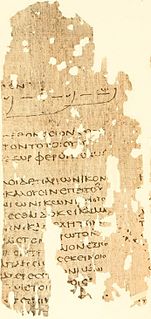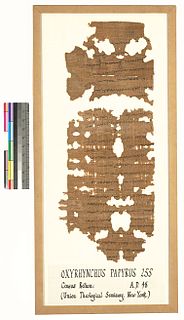 W
WCamillo Paderni, or Camillus Paderni, lived from ca. 1715-1781. He was an illustrator, excavator, and curator at the Museum Herculanense, as part of King Charles VII of Naples royal Palace in Portici, and a Roman.
 W
WThe Divination by Astrological and Meteorological Phenomena, also known as Book of Silk is an ancient astronomy silk manuscript compiled by Chinese astronomers of the Western Han Dynasty and found in the Mawangdui of Changsha, Hunan, China in 1973. It lists 29 comets that appeared over a period of about 300 years.
 W
WThe Herculaneum papyri are more than 1,800 papyri found in the Herculaneum Villa of the Papyri, in the 18th century, carbonized by the eruption of Mount Vesuvius in AD 79.
 W
WPapyrus Oxyrhynchus 8 is a fragment of Greek hexameter poetry. The dialect is a mixture of Aeolic and Doric. It was discovered by Grenfell and Hunt in 1897 in Oxyrhynchus. The fragment is dated to the first or second century. It is housed in the Houghton Library. The text was published by Grenfell and Hunt in 1898.
 W
WPapyrus Oxyrhynchus 16 is a fragment of the fourth book of the History of the Peloponnesian War by Thucydides in Greek. It was discovered by Grenfell and Hunt in 1897 in Oxyrhynchus. The fragment is dated to the first century. It is housed in the University of Pennsylvania Museum. The text was published by Grenfell and Hunt in 1898.
 W
WPapyrus Oxyrhynchus 29 is a fragment of the second book of the Elements of Euclid in Greek. It was discovered by Grenfell and Hunt in 1897 in Oxyrhynchus. The fragment was originally dated to the end of the third century or the beginning of the fourth century, although more recent scholarship suggests a date of 75–125 CE. It is housed in the library of the University of Pennsylvania. The text was published by Grenfell and Hunt in 1898.
 W
WPapyrus Oxyrhynchus 211 is a fragment of the Perikeiromene (976–1008) of Menander, written in Greek. It was discovered in Oxyrhynchus. The manuscript was written on papyrus in the form of a roll. It is dated to the first or second century. Currently it is housed in the Houghton Library (3734) of Harvard University.
 W
WPapyrus Oxyrhynchus 220 is a treatise on prosody, written by an unknown author in Greek. It was discovered in Oxyrhynchus. The manuscript was written on papyrus in the form of a roll. It is dated to the first century or second century AD. Currently it is housed in the British Library in London.
 W
WPapyrus Oxyrhynchus 221 contains Homeric scholia by an unknown author, written in Greek. It was discovered in Oxyrhynchus, Egypt. The manuscript was written on papyrus in the form of a roll. It is dated to the second century. Frederic G. Kenyon dated it to the first century or the first half of the second century. Currently it is housed in the British Library in London.
 W
WPapyrus Oxyrhynchus 246 is a fragment of a registration of some sheep, written in Greek. It was discovered in Oxyrhynchus. The manuscript was written on papyrus in the form of a sheet. It is dated to 24 July 66. Currently it is housed in the Cambridge University Library in Cambridge.
 W
WPapyrus Oxyrhynchus 255 is a fragment of a census return, in Greek. It was discovered in Oxyrhynchus. The manuscript was written on papyrus in the form of a sheet. It is dated to the 28 September – 27 October 48. Currently it is housed in the Union Theological Seminary in New York City.
 W
WPapyrus Oxyrhynchus 282 is a fragment of a Complaint against a Wife, in Greek. It was discovered in Oxyrhynchus. The manuscript, written on papyrus in the form of a sheet, is dated between 26 January 29 – 22 May 37. It is housed in the Beinecke Rare Book and Manuscript Library of the Yale University in New Haven.